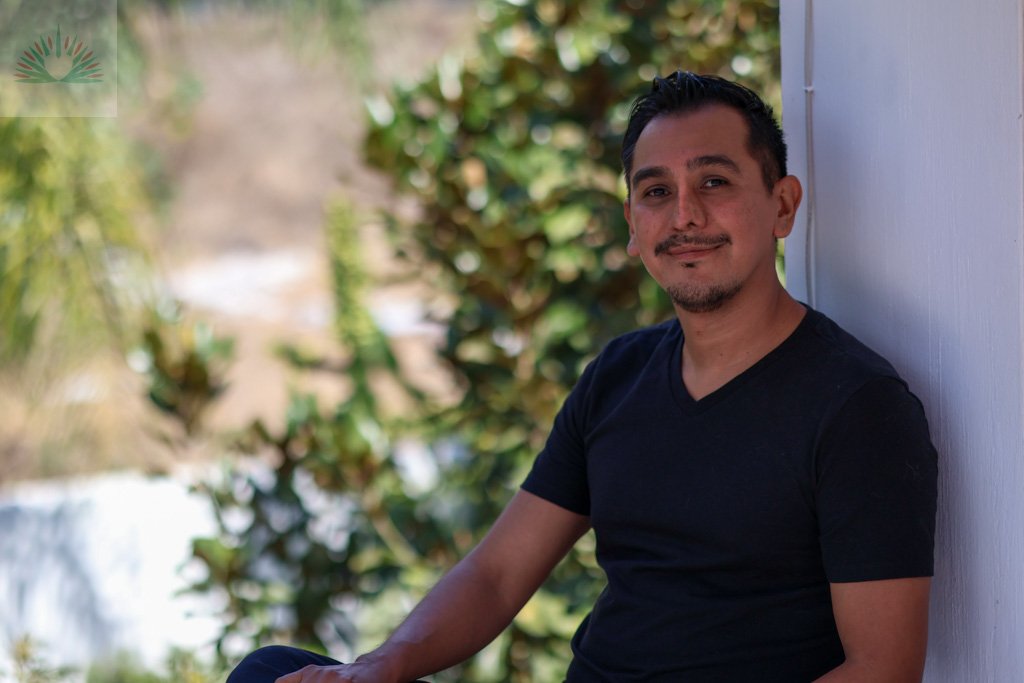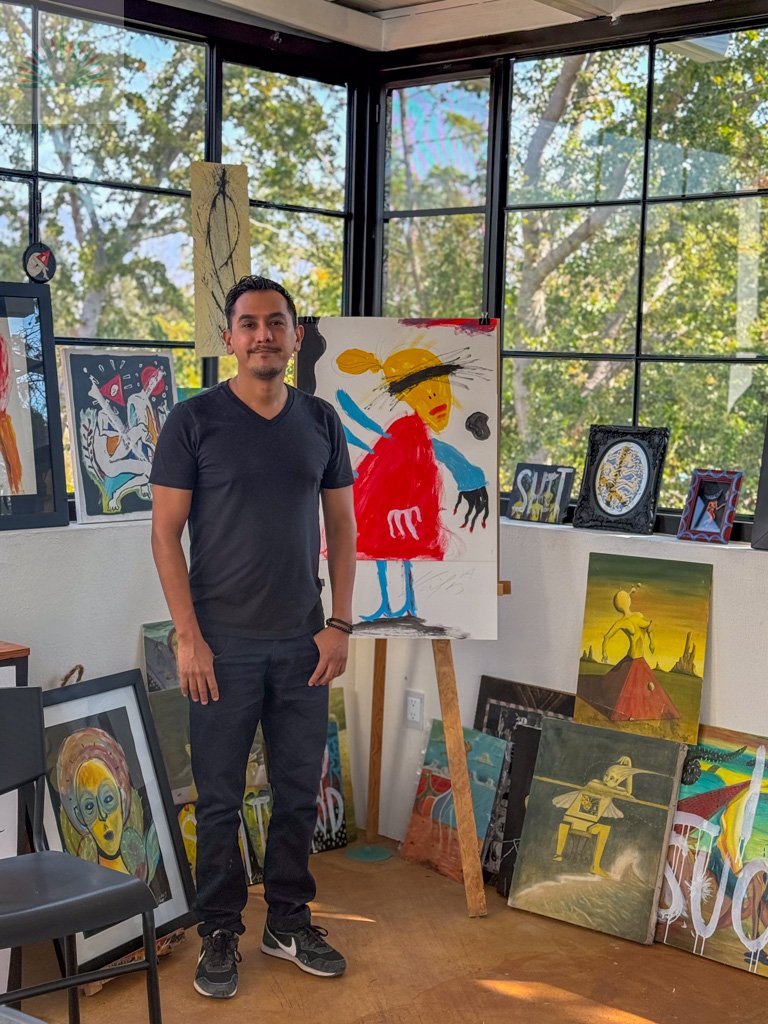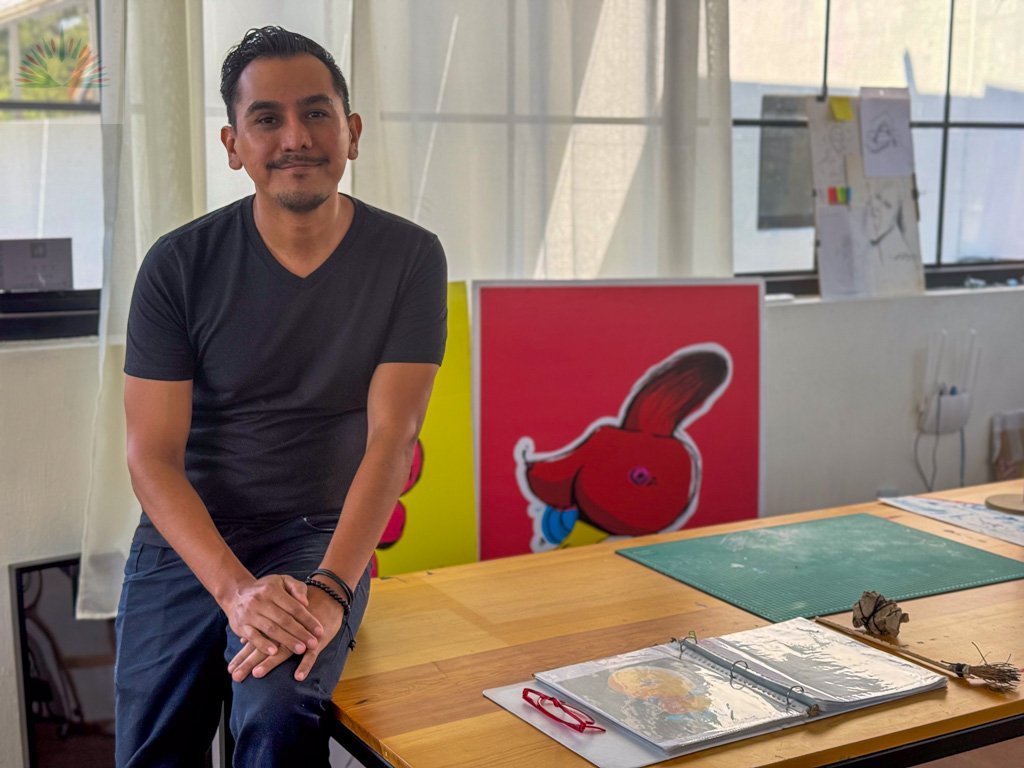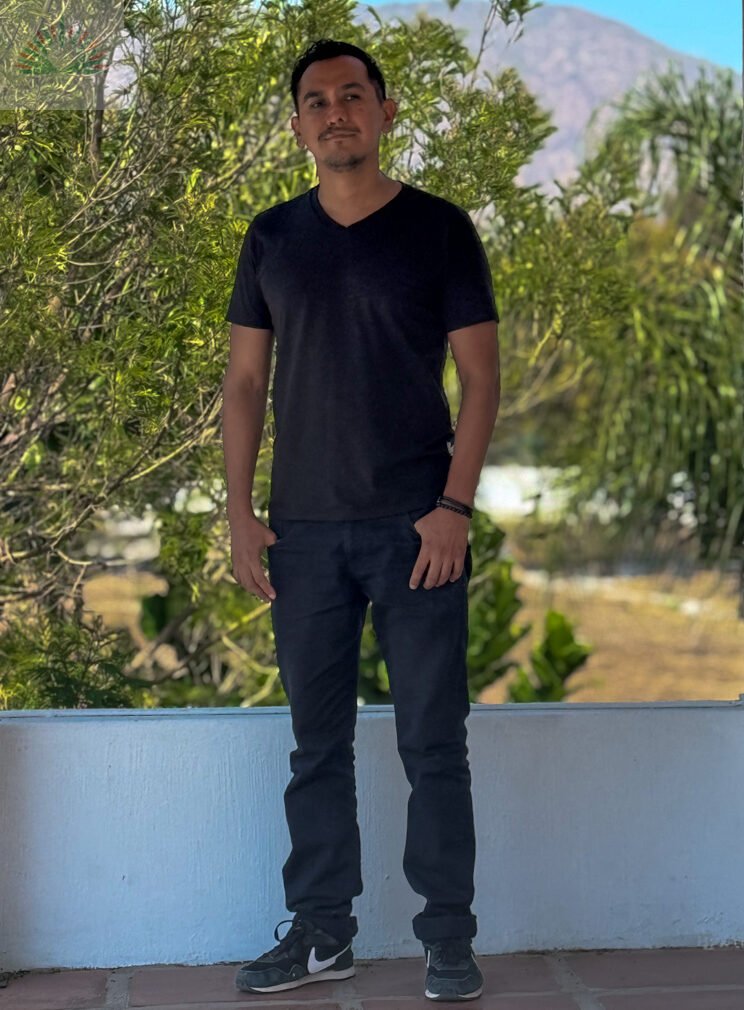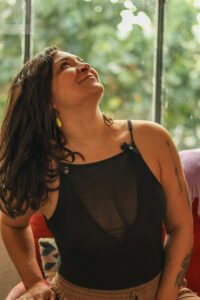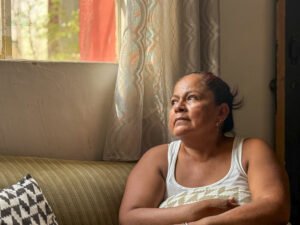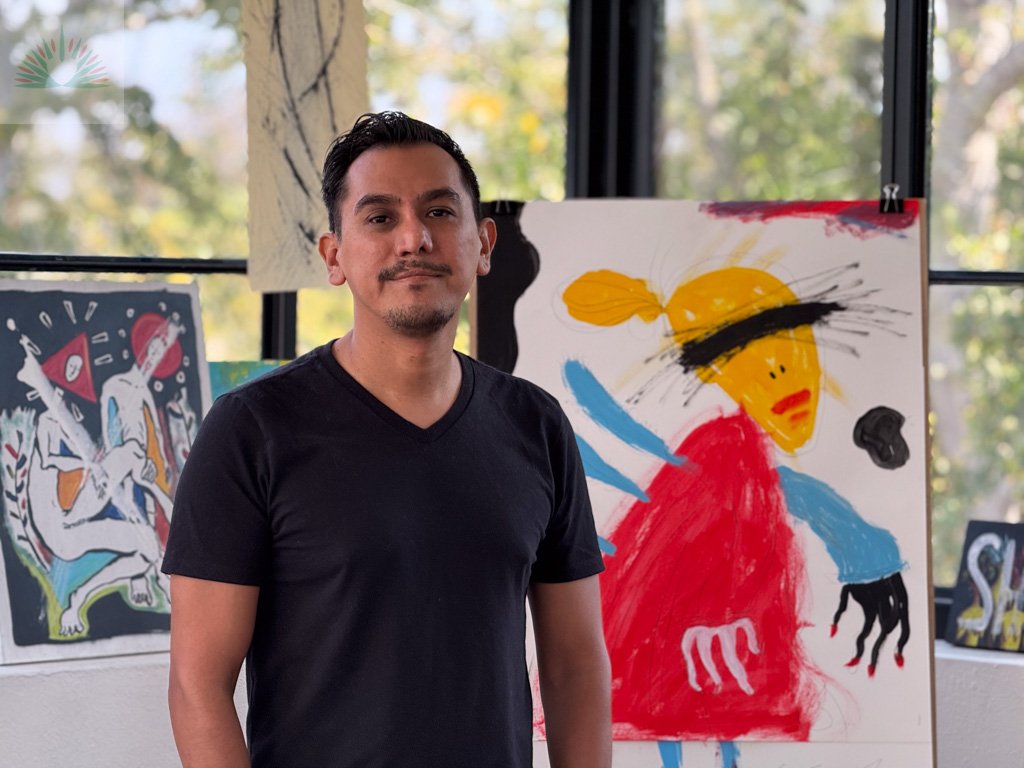
An immersive exploration of Mexican culture, heritage, and human connection—told through color, creativity, and community.
What if the most powerful stories about Mexico weren’t told in textbooks, tours, or tequila tastings, but in paint, in line, in soul?
We journey to Jocotepec, a lakeside town in Jalisco, Mexico, to explore how Mexican identity is being reimagined—through the brush of an artist named Chuy Vélez. His paintings quietly reframe what we think we know about Mexican identity, color, and truth.
And like many artists who blur the line between tradition and invention, Chuy’s work dares us to ask: What does it mean to be Mexican today? And what can art tell us that history books never will?
Let’s begin.
I met Chuy in his studio. Quiet, colorful, and surrounded by his work.
“Honestly, I struggle to say that my story is “unique.” I don’t know, maybe it’s the usual story. You start drawing as a kid. There’s that saying, right? That adult artists are just children who survived that stage of creativity and creation. I really like that idea because it’s true. When you’re a kid, you don’t know – you draw, build, invent, create—and you carry that with you. In general, I’d say most of my life, the important parts, have revolved around that. From experimenting with different materials, to new creations, to meeting people, being at events, doing exhibitions… all of that has been part of my life, and it’s very exciting. That’s what I’d say makes me “special.”
Chuy’s early drawings turned into a degree in graphic design, which turned into a career in both advertising and art. But what shaped him most weren’t institutions, they were people.
“I think someone who was really important was my sister, my older sister. We’ve always been close. And at some point, she’d always take me, well, whether it was to museums when I was a child, or… I already had this idea of design and building things, but she saw that in me early on. In childhood. She was the one who brought me there. She gave me my first contact with art, whether it was art at a gallery or an exhibit. And I think from that point on, I felt a connection to it.”
His journey began not in a museum, but at home. It was his sister who first took him to a gallery. His teachers helped shape the path. But it was the quiet, creative persistence that carried him forward.
But Art doesn’t exist in isolation. It speaks with ghosts and heroes: some close, some global.
“Well, as for artistic issues of influences, let’s say international ones, I saw the first painting by Salvador Dalí, who fascinated me. Yes, the one of Frida Kahlo at that time by René Magritte, and subsequently by Georgia O’Keefe. And…what’s his name… it slipped my mind—Chagall? Chagall—I really like him too. And recently there’s someone I really like whose last name is Lacon”
From surrealism to realismo mágico, his inspirations come from many countries, but the soul remains rooted in the surrealism of Mexico. It’s not an art movement. It’s a way of life.
“It has to do with, well, I define it as a mix between surrealism, neo-surrealism, a bit graphic, and even a little childish, maybe even a bit comic. I think this whole surrealist part, which is really the movement I love most, the surrealists, they have a strong connection with Mexico, and with Latin America more broadly, but especially with Mexico.
“The culture, in general, is surreal in Mexico, and if you’re observant, you can catch that—if you have a good eye, if you have a sensitivity to it—you can catch a lot of things…Hence, that famous quote from Salvador Dalí when he said, “I’m not coming back here because this country is more surreal than my paintings.”
Mexico is surreal. It’s realismo mágico in traffic jams and saints’ parades. Chuy doesn’t have to invent that energy—he just has to channel it.
But art is more than reflection. It’s a response, especially in times of crisis. In 2020, COVID changed how many of us saw the world, and how Chuy saw himself.
“You’re kind of the filter—for all the information from here that’s going to come out. And that’s what it is. For example, those paintings that have words on them, were written, honestly, during my moment of artistic crisis. I think it was even in the year of COVID, in 2020. Well, I was going through a moment that was artistically very foggy. I didn’t really see a lot of hope in what I was doing, you know?
“And that happens. And that’s what makes the work really personal and very sensitive. So, these paintings were made in a kind of… catharsis of, “I don’t like this,” or, “I messed this up.” And that happens.
“Now, for example, that period has passed. What I want to do with those paintings—for example, is resignify them. That’s the case with this one, for example, it has the word catártico—but now what I’m going to do is cover up those words and make them interact with the figure that was there before.”
A mirror to his inner world, and a bold act of vulnerability. Instead of hiding that pain, he painted it. Now, he’ll paint over it.
Art is a story. Even when it doesn’t tell you what to think. Especially then.
“It’s each story behind the painting. And above all… I don’t know, for example, my style is very colorful—and that has a lot to do with Mexican style, with the country itself, right?
“Where there’s so much diversity, where there’s a lot of culture, where we have many traditions, and all of that color that exists there, from the flowers in the fields, from the corn, from the music that’s very alive.
“I think that could represent that part—in the bright colors. Unconsciously. Because it’s not like it’s my intention, but unconsciously, it’s there.”
Bright colors aren’t decoration. They’re defiance. They’re dignity. They’re identity. But in a world that flattens culture into caricature, his truth breaks through in color: loud, joyful, and vibrant. That truth doesn’t live in the past. It evolves. It adapts
Some say tradition and modern art can’t coexist. Tradition versus technology? But for Chuy, they’re not opposites, they’re tools. He lives in the space where they blur.
“The truth is that it is the same. They’re right on the line, and it’s a really thin line. The only difference is, well, there are a lot of differences, but in terms of modernity, of technology, that’s exactly it: the tools you use to do it.
“But, ultimately, if your creation has a concept or a deeper idea, then all you’re really doing is changing the tools: from a brush and canvas and paint, to a tablet, to a mouse, and a stylus.
“I guess I’d say that’s the part I use to make my art ‘modern.’”
Tablet or canvas. Mouse or brush. His art isn’t about the tools, it’s about the soul behind them. The future of Mexican identity might just live in a Photoshop layer as much as it does on papel picado. Whether painting or clicking, what matters is the message. And that message doesn’t hang in silence, it lives in conversation. It lives where people gather.
In a town like Jocotepec, art isn’t behind glass. It’s at the market. On the street. In the faces of strangers. Jocotepec isn’t just where he paints. It’s where his art breathes.
“It’s kind of the final step in the artist’s work: the viewer. The reaction of the people.
And I’ve had wonderful experiences… and also some constructive criticism—haha. But, I mean, thankfully, most of it has been positive things and really, really funny reactions. I can see that in exhibitions, or even on my Facebook page, like in the comments and things like that. Or even at markets. Yeah, markets.
“I really like those because I have direct contact with the people. I’m there, they’re there, and my work is there, literally right in the middle, on the table. So it’s really gratifying to see people’s reactions, how they respond. Because clearly, they like it. And there are all kinds of reactions. That’s the part where I feel connected to people, to the community.”
For Chuy, community isn’t just where he lives. It’s who he paints for. His exhibitions happen in mercados and plazas. On Facebook pages and folding tables. Because that’s where truth lives—with people.
Art doesn’t just live in museums. It breathes in markets. In laughter. In shared glances at a painting. And just like that, woven into daily life, are the symbols that define a place.
We couldn’t talk about Jalisco without mentioning its most famous export: tequila. We asked Chuy about tequila.
“Obviously, I know it’s a cultural icon, internationally, because, of course, it has its own history. And around it, there are kind of… subcultures, so to speak. So that’s part of the country’s identity.
“It’s part of Mexico’s culture. I guess the history of it could reach international levels, because it’s a typical drink. It’s iconic. It’s really important in Mexico.”
Like art, tequila is more than a product. It’s a symbol. A ceremony. A story.
“I think that tequila, since it’s recognized internationally as being from Mexico, I mean, that alone already says something about the connection it has with the country.”
If you had to save one aspect of Mexican culture forever, what would you choose?
“One aspect of Mexican culture? Well, the most important, and the one I think has the most value—is humanism.
“Because I feel that’s what the world is missing right now. So, based on my experience, I’ve met people from other countries, and it’s clear they feel comfortable here. They like it. And not just comfortable—they feel really well received. Warm. Safe. Even despite all the problems we might have in the country.
“And that’s something we should protect. If there were just one thing, it would be that. Because that’s what’s going to keep us going in this world. That’s what’s needed right now.
In a globalized world where cultures are diluted for marketing, his art insists: we are not commodities. We are people: with depth, with history, with soul.
Ask someone abroad what they think of Mexico, and the answers may surprise you… or offend you. Poverty, danger, tequila. Chuy knows the tropes: Lazy. Poor. Corrupt..
But his art tells a fuller truth, one painted in complexity and color.
“I think there was this kind of… this kind of concept of Mexicans as lazy, right? Or, like there was a lot of danger in Mexico. I believe, at least from my perspective, that’s changing. I also think, in general, this vision/idea is changing. Because, obviously, it’s also been shown that Mexicans are very hard-working, both here and in other countries. And all of that was born out of the same society.
“I’m very proud of my country. The more I meet people from other places, the prouder I am of my country. Thanks to that, I’ve been able to see things that, well, that many of us Mexicans are already used to—but in many other countries, those things don’t exist. And I don’t mean material things. I mean behavior, people, culture, and traditions. So that’s basically it, I’m really proud to be part of this community. To be Mexican. And to be part of all the traditions.“
Chuy’s truth? Mexicans are resilient. Creative. Full of contradictions, and beauty. The narrative isn’t being rewritten from the outside. It’s being reclaimed from within. Through brushstrokes, through colors, through quiet rebellion, Chuy paints a complete story. One that includes struggle, beauty, joy, and pride.
So what does he want us to take from all of this? What legacy does he hope to leave behind?
“I’d just like to know, or rather, like to see, what people’s interpretation of my work would be. For me, my work is something very, very, very personal, obviously. And I guess the goal I have, or would have, is just that people like it. That they appreciate it.
“And that it gives the world a little more sensitivity, you know? That’s what I was saying before, that’s kind of part of what art is for.
“Because It would be precisely this: first, to have persistence. In general, art requires a lot of persistence. I think it’s a big part of what it takes to keep going: persistence and hope.
And also a lot of work, in terms of technique, in terms of themes. And also, being very open to creativity, not limiting yourself to one theme, and exploring, right?
“And for me, the most important thing is staying in touch with yourself: with your being, your conscience, your soul. Also with the community, but the community is part of that. So, the closest thing to you is your soul and your conscience. And I think that’s a very essential part of being able to make art.”
He doesn’t chase fame. He doesn’t want to be famous. But to be free. And he hopes future generations do too.
“I think artistic work is freedom. Freedom of creation, freedom of knowledge, or freedom of living. I try to make my art be free, like how sometimes the lines are free. Art is free, my mind is free, my soul is free.
“This capacity that human beings have to create freely, that’s what I’d like to be touched on in future generations. That there wouldn’t be limits in many ways. But especially in the sense of creativity—no limits.”
So what is the canvas of truth?
Maybe it’s not one painting. Maybe it’s a thousand colors stitched together. Maybe it’s vulnerability. Maybe it’s joy.
We began with a question: What can art tell us that textbooks can’t?
Maybe this:
That identity isn’t fixed.
That truth lives in color.
That being Mexican, like being human, isn’t one thing. It’s many.
And that’s what Chuy paints.Gracias, Chuy.
Gracias, México.
